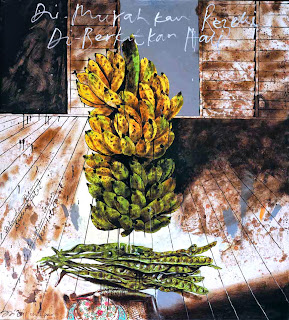Favourites from the Zain Azahari Collection @ The Edge Galerie
Pastoral, sensual, vigorous - these common descriptions surmise the prominent art collection of Zain Azahari, where a selection of 38 pieces are displayed at this exhibition. Large works by Ibrahim Hussein and Hendra Gunawan greet the visitor with titillating intent, where Fauvist colours and sinuous contours excite primitive human senses. Flanking both sides of the lobby, Latiff Mohidin and Anuar Rashid arouse the spiritual with abstract illustrations of great control and harmonious beauty, easily subjugating works by young artists hung in the same area. Ramlan Abdullah's aluminium sculpture also blends into the gallery's medieval design, as the contemporary takes a back seat to master artists belonging to the Modern era. Earth and human form an unbreakable bond in these works, implying the collector as one whom possess deep faith and a resilient outlook of life.
 |
| Kampung truths: Jalaini Abu Hassan - Di Murahkan Rezeki, Di Berkatkan Hati (2011) |
This philosophy is clearly specified in Jalaini Abu Hassan's meditative 'Di Murahkan Rezeki, Di Berkatkan Hati', a minimal juxtaposition of objects (by Jai's standards) beautifully rendered, where words elucidate Malay sayings and its connotations. When utilised correctly, writing creates additional dimensions on a canvas, Mangu Putra's picture of utter despair being a good example. Academic painting typify depictions of toil and hard work, contrasting with the creative expressions of Mount Merapi by Affandi and Srihadi Soedarsono. Illustrations of human feet seem to captivate the collector, who own a couple of high-priced watercolour masterpieces by Chang Fee Ming. Among the elegant dancing figures shown, including Latiff's curious 'Bird Dance' sculpture, a menacing 'Barong' by Popo Iskandar emerges proudly from the shadows.
 |
| Crimson tide: Latiff Mohidin - Malam Merah (1968) |
Zain's collection boasts many works by the renown Latiff, none more significant than 'Malam Merah'. Lively strokes of purple, yellow, and white, provide an inherent energy to the amalgamated Pago-pago, as a single horizontal line allows the sun / moon to set. The remaining areas are painted crimson red, while darker brush strokes sketch movement that augments the powerful picture. Cheong Soo Pieng's tender 'Mother & Child' follows in the Nanyang tradition, which the pioneer artist updates via a rare oil painting. Previously unseen to the public is Ib's 'Farewell to New York', a witty nude done in his characteristic Pop manner, where the curious usage of brown as its background has me polishing my chin while pondering the rationale. More sensuality is exhibited in Anthony Lau's 'Exstacy', a wooden pair of smooth forms that recall natural contours, its overt tension depicted in the horizontal gap.
 |
| From Kahlo, Van Gogh, Bueys, Sudjojono, Freud, to Hiroshige: Agus Suwage - Pemandangan Dunia Wi (Earthly Landscape) (2011) |
Hung low to provide viewer clarity, many works from this collection are museum-worthy, with the occasional odd gem standing out beyond Nusantara motives. Dzulkifli Buyong's quirky 'Four Friends' "captures that single moment that is the birth of our Malaysian Modern art movement", as described by curator Anurendra Jegadeva. Simple pastel colours, gliding sarongs, lily buds in the air, and innocent human gestures - I will not be surprised if the artist was in fact drawing 4 versions of his self. Moving from flying figures to floating heads, Agus Suwage's brilliant red fields pay tribute to artistic influences in an unconventional manner, the depiction like a tinted collage filtered through a computer program. Singling out figurative subjects is Ahmad Zakii Anwar's contemporary approach, the huge portrait of a hippopotamus beckoning the viewer to come closer and swat flies, while the logical me clamour to inject meaning into a successful aesthetic.
 |
| Why brown? Ibrahim Hussein - Farewell to New York (1969) |
Despite having a shorter tradition in picture making, the Malaysian works hold their own when compared to the diversity displayed in the Indonesian paintings. Among the many natural landscapes, a hazy wetland and a vertically-stretched Batu Caves signify personal importance, the former a nostalgic memory and the latter being Zain's first collected artwork (a wedding gift!). Zain's stories and passion are expounded and repeated across few essays in the catalogue, inspiring all who appreciate art. Having amassed 400 works over the past 50 years, Zain Azahari's collection is a testament of one's relentless pursuit of art on one's personal terms. Not a luxury item, never an asset type, consistent in vision, absorbing one's soul and intellect. I may not share Zain's taste in art, but I do share a similar passion, which makes him my Art Collector idol for years to come.
 |
| Gliding sarongs: Dzulkifli Buyong - Four Friends (1964) |
Comments
Post a Comment